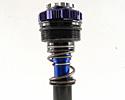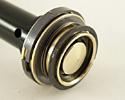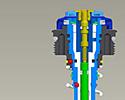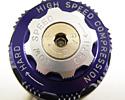
Recently on Cyclingnews.com |
Tech Feature: Inside Rock Shox' new Mission Control damper, January 22, 2007
The secret life of Rock Shox' new Mission Control damper
By James Huang

|
In the bicycle suspension world, dampers have a pretty rough life. At the most basic level, their job is simply to convert kinetic energy into friction (usually by forcing a non-compressible viscous fluid through small ports), so that that energy is absorbed by the suspension instead of the rider. Compression dampers, in particular, get the short end of the stick. While rebound dampers generally have to deal with smaller amounts of energy and a narrower range of extremes, compression dampers are subject to a much wider variety of impact sizes and speeds. As such, they should ideally be suited for any and all conditions for which they are designed.
To add insult to injury, the compression damper lives a virtually glory-free existence: the vast majority of its life is spent bolted inside a suspension fork, bathing in a nasty pool of suspension oil, oftentimes never to see the light of day (and thus, sorely neglected). When it's working well, it can be almost singularly responsible for keeping your wheel on the ground, yet it's a thankless job that garners virtually no praise but still the draws the ire and rage of its owner when it has a bad day. Important job or not, let's just say that 'compression damper' doesn't sit very high on my list of 'things I would like to come back as in a future life'.
Rock Shox turns its ship around

|
Rock Shox turned around its at-the-time somewhat tenuous condition back in 2004 with the introduction of its Motion Control damper. The surprisingly simple (read: durable) and elegant layout utilizes a relatively basic orifice-type damper plus a supplementary blowoff valve, but careful execution of the design delivered extremely competent bump performance that was also very user-friendly to boot. In spite of criticisms that the design used too much plastic (in actuality, the design would have been nearly impossible to craft in metal), the system has proven to be impressively durable.
However, Motion Control is far from the be-all-end-all of compression damper designs. In particular, long-travel (these days considered to be roughly 120mm+) single-crown forks present among the most challenging conditions for a damper to handle, and it is in these unique applications that Motion Control is not ideally suited. Those forks arguably witness the widest range of usage conditions, from relatively pedestrian trailbike to more aggressive all-mountain/freeride applications that can sometimes border on DH classification under certain pilots. Moreover, these forks are often just as likely to be ridden uphill in addition to down, and must make concessions to pedaling efficiency and light weight without sacrificing bump performance.
At the higher damper shaft speeds and more aggressive applications that are often associated with longer travel, the simple-yet-effective architecture of Motion Control essentially has a little too much to deal with. As such, since its introduction, Rock Shox has only utilized it in short-to-mid travel platforms, with the exception of the Boxxer which uses a modified "Speed Stack" version.
A crowded party, but everyone wants to get in

|
Not surprisingly, suspension companies across the board have tended to pack their most advanced technologies into the long-travel single crown categories, but it is in exactly this segment that Rock Shox has often struggled in the past (anyone remember the Psylo? Um… sorry to have dug that one up for you. Back to therapy you go). Knowing the uphill battle it faced, Rock Shox knew that it would be given little leeway, if any, as it attempted to re-enter the fight with its new Lyrik and Totem lines.
The bicycle suspension icon took the lessons learned from Motion Control to develop a wholly new damper specifically designed for these applications. The new damper, dubbed Mission Control, is the first from Rock Shox to offer completely separate, and fully-tunable, low-speed and high-speed compression damping circuits. Low-speed inputs are still handled by a simple orifice-type design that incorporates an adjustable port, similar to most other designs currently on the market. High-speed inputs, however, are now handled by a dedicated shim stack, located just atop the main piston body. Under more extreme conditions, this additional circuit delivers more carefully controlled oil flow for better control. User-tunability is provided by the cleverly-integrated adjustable spring preload on the stack.
Both of these circuits are supplemented by a downsized version of Rock Shox' Floodgate platform valve design. Unlike the large red Swiss-cheese-like 'spring tube' layout of the Motion Control damper, Mission Control incorporates a dramatically downsized version that utilizes the company's new Isolite material to deliver largely the same functionality. As with the original Motion Control, the Floodgate platform threshold is externally adjustable. A simple crown-mounted switch toggles the platform feature on and off in this case, but in either setting, both the low-speed and high-speed circuits remain fully functional when the fork is active.
Complicated yet simple

|
This wealth of adjustment means that the new damper design should offer a suitably wide range of adjustment for a correspondingly wide range of conditions. At the same time, however, many users may be intimidated by the potential for getting things wrong. Thankfully, all of the compression damper adjustments are located atop the crown (with nicely machined, anodized, and laser-etched finger-friendly aluminum knobs), and are also detented for easy recording of settings. Moreover, Rock Shox also has a setup guide in the works for easier deciphering of adjustments.
Our own experiences on the new Mission Control damper have still been somewhat limited to date (curse this rash of Colorado snow!), but promising nonetheless based on earlier rides in Moab, UT earlier this past season. We'll provide more in-depth account of Mission Control's long-term prognosis once we've thoroughly thrashed our long-term Lyrik 2Step Air test fork, but as far as we can tell so far, Rock Shox is well on its way to purging its past demons.
Photography
For a thumbnail gallery of these images, click here
Images by James Huang/Cyclingnews.com
- Rock Shox' new Mission Control damper is a cleanly constructed compression damper offering a wide range of low-speed and high-speed compression damping, in addition to a user-tunable platform feature.
- Misson Control inside and out. Needless to say, packing all of those features into a single assembly involves a number of intricate parts.
- Low-speed damping adjustments are made by altering the size of the orifice-type oil port. A top-mounted knob varies the position of the valve (pink).
- The platform on Rock Shox' new Mission Control damper is turned on or off using a crown-mounted toggle switch that opens or closes the Motion Control valve (blue), located at the very bottom of the damper.
- High-speed compression damper adjustments alter the spring preload on the shim stack (green), located on top of the piston body.
- Rock Shox equips its new Lyrik and Totem with a two-stage rebound damper that it says is better able to handle longer-travel applications than single-circuit dampers.
- Nicely machined and anodized aluminum control knobs sit atop the crown for easy access.
- The dedicated high-speed compression damping shim stack sits atop the piston body and is normally preloaded by the black aluminum sleeve (pulled up for easier viewing).
- Rock Shox' Motion Control platform valve has been dramatically downsized for use in the new Mission Control damper. Beneath the gold mushroom-shaped "plunger" sits a unique Isolite cushion that compresses under strong impacts to allow oil flow when the fork is otherwise locked out.


